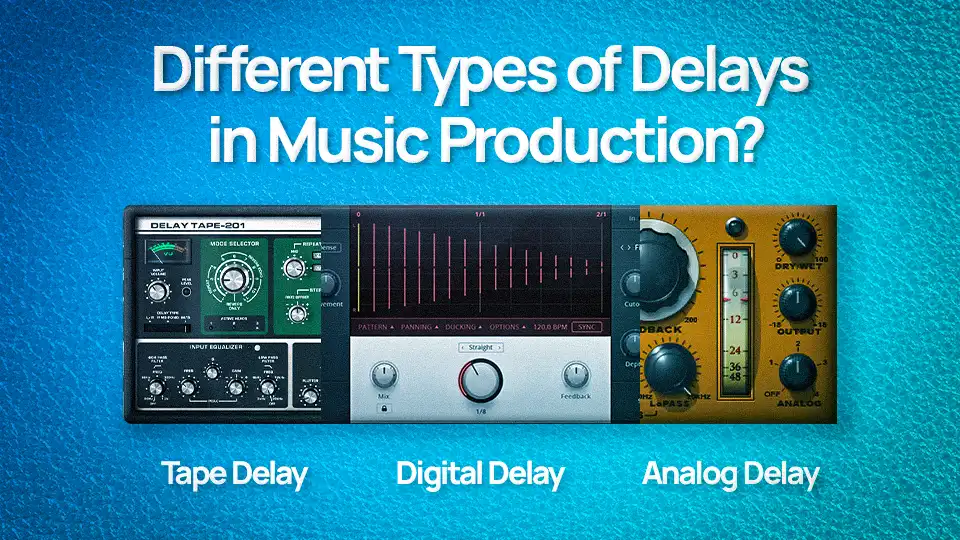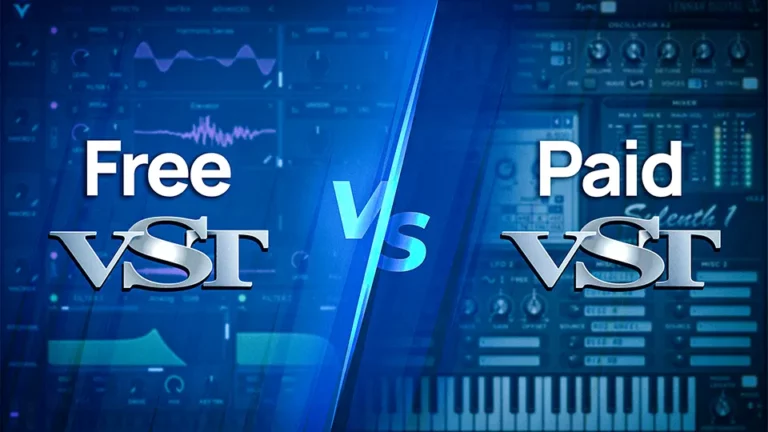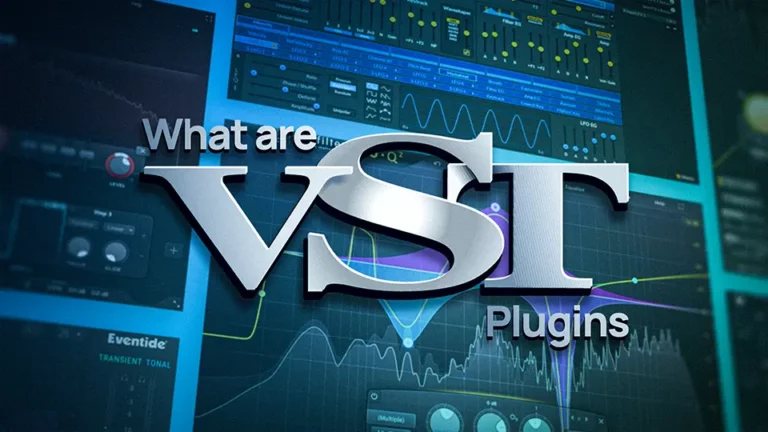What are the main types of delays that have captured music enthusiasts for decades and how can they be achieved using the best delay plugins?
Delay, in music production, is an effect that repeats a sound after a set interval of time. It creates a sense of space and depth, adding texture and richness to a mix.
The different types of delay, each with its unique sound, have been used by legendary musicians and producers to create timeless music.
So, come along on a journey of discovery with me as we explore the main types of delay and the different effects they offer.
What is Delay in Music Production?
Delay in music production is a simple yet powerful effect that adds a mesmerizing touch to a mix. It creates a repetition of a sound after a specified interval of time, adding depth, texture, and richness to the overall sound.
Think of it as a musical echo that enhances the sound of instruments and vocals. With the delay, you can create the illusion of a larger space, making the music sound more spacious and captivating.
From tape-based delays of yesteryear to the digital delays of today, the evolution of delay has been a constant journey of discovery and creativity. And, as we delve deeper into this fascinating world, we will discover the many different types of delay and their unique sound.
What are the Main Types of Delays?
The art of delay has many forms, each with its own unique character. Three main types of delay are Tape Delay, Analog Delay, and Digital Delay.
Tape Delay, a classic sound from days of old, creates a warm and natural echo with its analog circuitry.
Analog Delay, its sibling, brings a vintage vibe with its distinct sound and modulation options.
Digital Delay, the modern marvel, delivers pristine and precise repeats with its cutting-edge technology.
Each type offers a different flavor and a different color to the musical canvas. And the choice of which to use lies with the artist’s ear.
So let us delve deeper into each type, and discover the beauty of delay. For its echoes will sing, its repeats will ring, and the music will soar with new life.
Tape Delay
Tape Delay, the classic sound of yesteryear, brings a warm and natural echo to the mix.
With a vintage vibe and a unique character, Tape Delay is a type of delay that adds a touch of nostalgia to any track.
But what if you don’t have a tape machine? Modern technology has given us Tape Delay emulation in the form of VST plugins.
As an example, here are some:
Timeless 3 by Fabfilter
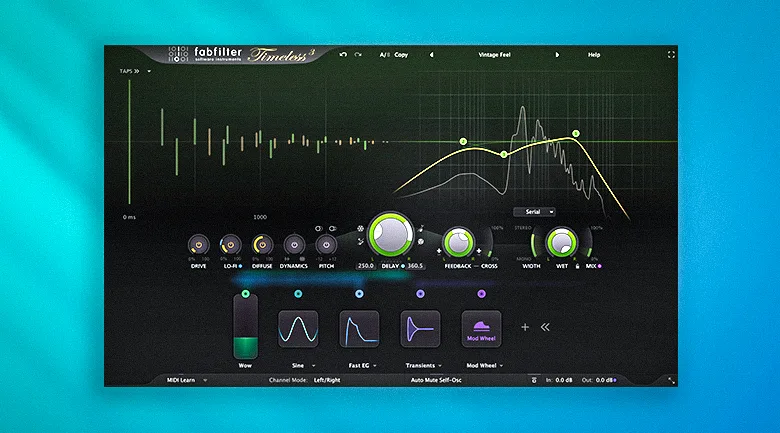
FabFilter Timeless 3 is a high-quality delay plugin that is used in the audio production industry. It has many features such as five unique effects, six analog-sounding filters, and a drag-and-drop modulation system. The sound quality is warm and rich, and the plugin has a number of optional effects that add depth and dimension to the delays.
EchoBoy by Soundtoys

EchoBoy is a delay effect plugin developed by the company Soundtoys. It is a versatile and powerful tool for music production, offering a wide range of echo effects from classic vintage tones to modern and experimental textures. It has 30 built-in styles modeled on vintage gear, a chorus effect, and various modes for customization.
These digital simulations offer the sound and feel of the real thing, with the convenience and flexibility of digital technology.
So whether you’re after that classic analog warmth or simply looking for a new sound, Tape Delay is a perfect choice.
It will wrap your music in a warm embrace, and its echoes will linger, filling the mix with depth and character.
So why not give Tape Delay a try, and let its natural beauty enhance your music production today?
Analog Delay
Analog Delay, a vintage voice, brings a unique character to your music.
With its analog circuitry and bucket-brigade chips, it creates a warm and organic sound. Modulation options, such as chorus and vibrato, add an extra layer of depth and movement to the echoes.
What if you don’t have an analog delay unit? VST plugins provide analog delay emulation.
Here are a few examples:
Colour Copy by U-He
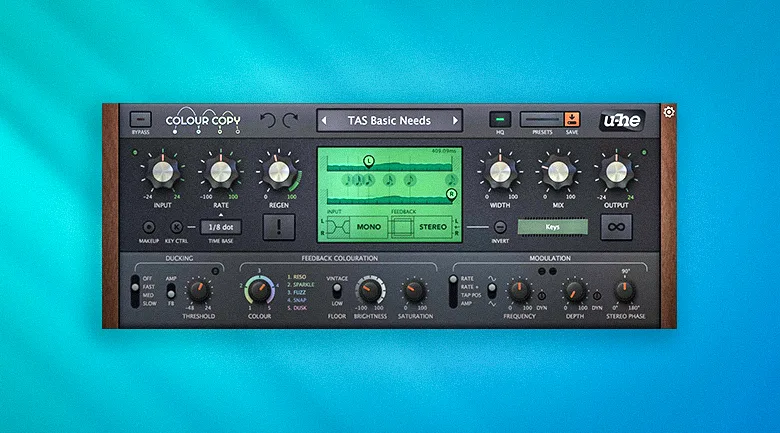
Colour Copy is a virtual analog delay effect plugin for music production, developed by the company U-he. The plugin is designed to provide users with the classic sound of bucket-brigade delays (BBD) with the added benefits of modern features. It offers a unique color morphing feature, which allows for saturation and non-linear effects such as distortion and resonance.
Repeater by D16 Group

Repeater is a delay plugin developed by D16 Group and Slate Digital that allows users to add depth, space, and excitement to their music. It has 23 unique delay units that are modeled after classic and vintage designs.
With digital simulations, you get a real-life experience with the convenience and flexibility of digital.
The Analog Delay is a great choice if you want that classic analog warmth or just a new sound.
Your music will have a vintage vibe, and its unique voice will stand out.
Digital Delay
Digital Delay, the versatile sound of today, brings precision and clarity to the mix.
With its digital circuitry and advanced algorithms, it offers a wide range of delay options, from simple echoes to complex rhythmic patterns.
Control options, such as tempo sync and modulation, add an extra layer of versatility to the delays.
And the best part? Digital Delay is always at your fingertips, whether you’re in the studio or on the go.
An example would be:
Replika XT by Native Instruments
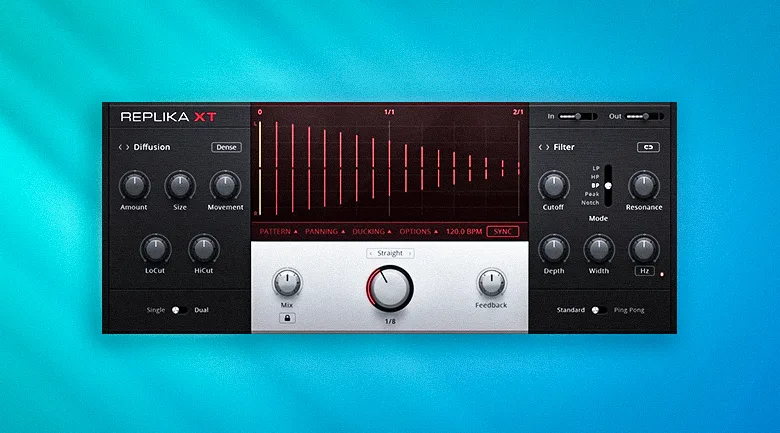
Replika XT is a multi-mode delay plugin created by Native Instruments. It is considered one of the best delay plugins available, offering a high-quality sound and a wide range of features for creating intricate rhythms and mixing tricks.
Just plug in your device and you’re ready to add some delay to your music.
You can use Digital Delay for either a clean and crisp echo or something more experimental.
It will add a modern touch to your music, and its precise and versatile sound will enhance the mix.
Different Styles of Delay Effects
Different styles of delay effects, a world of creative sound at your fingertips.
From the gentle sway of a Ping Pong Delay to the complexity of a Multi-tap Delay,
there’s a delay effect for every style and genre of music production.
Let’s dive into some of them.
Ping Pong Delay
In the world of sound production, delays can make a simple beat into a complex musical masterpiece.
One such effect is the ping-pong delay. This effect creates a back-and-forth bouncing sound that resembles a game of table tennis. To achieve this effect, the sound is repeated and bounced between the left and right channels, giving the impression of a sound that’s bouncing back and forth.
Think of the crisp, rhythmic sound that underscores your favorite songs, that’s the magic of ping-pong delay. This delay effect adds depth and movement to a mix, making it ideal for genres like electronic dance music or ambient music.
Whether it’s a subtle effect used to enhance a beat or a bold statement that drives a track, the ping-pong delay is a versatile tool for sound engineers and music producers alike.
Multitap Delay
Multitap Delay, a complex echo effect, is an artful creation for sound enthusiasts.
It’s a delay line that contains multiple taps, each with its own adjustable delay time and gain. This gives the sound designer a vast array of echoes to play with.
The beauty of Multitap Delay lies in the ability to manipulate each individual echo, creating unique soundscapes that envelop the listener. The sound can range from tight, rhythmic patterns to spacious and atmospheric soundscapes.
It’s like having a virtual echo chamber, where the echoes bounce around in your mind’s eye, each with its own story to tell.
Slapback Echo
A sound that bounces back with a delay, echoing through the air – that’s what you get with a Slapback Echo. This classic effect has been used in many iconic songs, adding depth and dimension to the mix. It’s a simple but effective technique that can transform a plain recording into something that’s truly special.
To create a Slapback Echo, the sound is recorded, then played back with a delay of around 70-150 milliseconds. This creates a subtle repetition of the original sound, making it seem as if it’s bouncing back and forth between two walls. It’s a great way to add a sense of space and atmosphere to a recording, making it sound larger and more dynamic.
The best part about the Slapback Echo is that it’s easy to use. You can create it using hardware effects pedals or software plugins, or even by recording it live in a large room.
Doubling Echo
In the world of audio, the term “doubling echo” refers to a unique effect that creates a sense of depth and space in your sound. This type of delay effect takes a single sound and repeats it several times, creating a sense of a chorus or background harmony. The trick to creating this effect lies in the timing of the repeats and the volume levels used.
Think of it like a musical echo, where you sing a note and then hear it repeated back to you with a slight delay. Doubling echo works in the same way, adding layers to your sound that helps to fill out the audio spectrum and create a richer, more complex soundscape.
For those looking to experiment with this style of delay, you don’t need to invest in expensive hardware. Many digital audio workstations and VST plugins offer a doubling echo effect that can be easily applied to your tracks.
Looping Delay
Looping delay is a type of delay effect that records and repeats a sound, creating a continuous loop. This effect is commonly used in various musical genres to create unique soundscapes and textures. Looping delay is often achieved through the use of hardware pedals, digital plugins, or software applications.
The beauty of a looping delay lies in its ability to create intricate and evolving sounds from a single, simple input. With careful control of the delay time, feedback, and other parameters, musicians can produce complex, evolving sounds that can fill an entire mix or be used as a rhythmic foundation.
Modulated Delay
Modulated delay is a unique and captivating effect that adds depth and texture to sound. In simple terms, it’s a delay effect that has been altered by modulation. This can create a sweeping, pulsating sound that can range from subtle to dramatic.
Modulated delay works by modulating the delay time of the effect, creating a shifting and moving sound. This is done through the use of an LFO, or low-frequency oscillator. The LFO changes the delay time, creating a rhythmic effect that is musical and dynamic.
There are different types of modulation that can be applied to a delay effect, such as pitch modulation or filtering modulation. This allows for a wide range of creative possibilities, from creating simple repeating patterns to complex soundscapes.
Modulated delay is a popular choice for adding life and energy to music production. It can be used to add depth to a mix, create interest in a breakdown, or add energy to a chorus.
